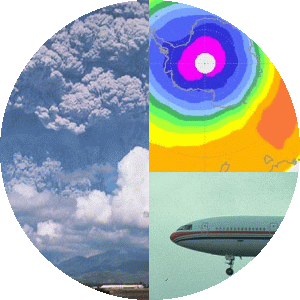 > English > Climate Encyclopaedia > Upper Atmosphere > basics
> English > Climate Encyclopaedia > Upper Atmosphere > basics
|
Upper AtmosphereBasics |
The upper atmosphere and stratospheric processesAbove the clouds, the air becomes very thin and dry. The upper atmosphere still contains some air, but 80% of the air mass around the Earth is now below us.
|
|
Few chemical compounds make it up to such high altitudes in the atmosphere as the tropopause traps most of them. However, the upper layers of the atmosphere are important to life on Earth. These layers prevent highly energetic, damaging, radiation from the Sun reaching the surface of the Earth. The stratosphere, which includes the ozone layer, is the lowest and most prominant layer of the upper atmosphere. 1. Basic understanding and observations of the mid atmosphere - Layers of the atmosphere and changes in meteorological parameters
|
2. The ozone hole and chlorofluorocarbons - Ozone formation, absorption and the ozone layer
|
|

